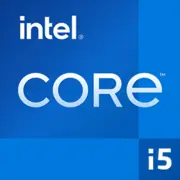Intel Core i5-11600

Intel Core i5-11600: Review and Build Recommendations for 2025
April 2025
1. Key Specifications: Architecture, Process Technology, Performance
Code Name and Architecture
The Intel Core i5-11600, released in 2021, belongs to the Rocket Lake generation. This is Intel's last line on the 14nm process technology that the company has been using since 2015. Despite the “age” of the technology, the processor features an updated microarchitecture called Cypress Cove, which improved the IPC (Instructions Per Cycle) by 19% compared to its predecessors.
Performance
- Cores and Threads: 6 cores, 12 threads.
- Frequencies: Base - 2.8 GHz, maximum turbo frequency - 4.8 GHz (for a single core).
- Cache: 12 MB L3.
- Graphics: Intel UHD Graphics 750 (base frequency - 350 MHz, maximum - 1.3 GHz).
- Benchmarks: In Geekbench 6, it scores 2137 in single-threaded and 7947 in multi-threaded mode.
Key Features
- Supports PCIe 4.0 (up to 20 lanes).
- Technologies like Intel Turbo Boost 3.0, Hyper-Threading.
- Integrated graphics for basic tasks.
2. Compatible Motherboards
Socket and Chipsets
The processor uses the LGA 1200 socket and is compatible with the 500 series chipsets:
- Z590: For enthusiasts (overclocking, PCIe 4.0 x8/x8 for dual GPUs). Price in 2025: $120–200.
- B560: The optimal choice (supports memory up to DDR4-3200, PCIe 4.0 for NVMe). Price: $90–150.
- H510: Budget option (no overclocking, limited number of ports). Price: $60–100.
Examples of Motherboards
- ASUS TUF Gaming B560-PLUS: A reliable model with VRM cooling (around $130).
- MSI Z590-A PRO: For overclocking, supports two M.2 PCIe 4.0 ($150).
Selection Tips
- If you don’t plan to overclock, get the B560 — it’s cheaper and supports memory XMP profiles.
- For a build with a discrete GPU PCIe 4.0 (e.g., NVIDIA RTX 3060), choose a board with PCIe 4.0 x16.
3. Supported Memory Types
The i5-11600 works only with DDR4 (up to 3200 MHz in Gear 1 mode). In 2025, this looks outdated against DDR5, but such modules are cheaper:
- 16 GB DDR4-3200 (2x8 GB) — $50–70.
- 32 GB DDR4-3200 (2x16 GB) — $90–120.
Recommendations
- Use a dual-channel configuration for maximum performance.
- Avoid memory higher than 3200 MHz — the processor may operate unstably at higher frequencies.
4. Power Supply: Calculation and Recommendations
Power Consumption
With a TDP of 65 watts, actual consumption under load reaches 120–140 watts. Considering a graphics card (e.g., RTX 3060, 170 watts), the minimum power supply wattage should be 500 watts.
Examples of Models
- Corsair CX550M (550W, 80+ Bronze): A reliable choice for $70.
- Seasonic Focus GX-650 (650W, 80+ Gold): For power headroom ($100).
Tips
- Don’t skimp on the PSU: cheap models may exhibit instability under peak loads.
- If you plan to upgrade the GPU in the future, get a PSU with an additional 100–150 watts.
5. Pros and Cons
Advantages
- Price: In 2025, it costs $150–180 (new) — half the price of modern equivalents.
- Energy Efficiency: Suitable for compact PCs (SFF) with a TDP of 65 watts.
- Gaming Performance: Sufficient for 60+ FPS in Full HD (e.g., Cyberpunk 2077 at medium settings with RTX 3060).
Disadvantages
- 14nm process technology: High heat generation under load.
- No DDR5 and PCIe 5.0: Limits upgrade potential.
- Weak iGPU: UHD 750 is suitable only for office tasks.
6. Usage Scenarios
- Gaming: Optimal for Full HD/1440p with a discrete GPU (RTX 3060, RX 6600 XT). In CS2 or Fortnite, it shows 120+ FPS.
- Work Tasks: Video editing in Premiere Pro, 3D rendering in Blender (but slower than Ryzen 5 7600X).
- Multimedia: Streaming in OBS without lag thanks to 12 threads.
7. Comparison with Competitors
- AMD Ryzen 5 5600X (2020): Better in multi-threaded tasks (6 cores/12 threads, 7nm) but more expensive ($200 in 2025).
- Intel Core i5-12400F (2021): 15–20% faster thanks to Alder Lake architecture, but requires DDR5.
- Ryzen 5 7500F (2023): Supports DDR5 and PCIe 5.0, but is pricier ($220).
Conclusion: The i5-11600 is only a good option on a limited budget or for upgrading an old system on LGA 1200.
8. Practical Tips for Building
- Cooling: The stock cooler is adequate for basic tasks, but for turbo mode, install a tower cooler (e.g., DeepCool Gammaxx 400, $30).
- Case: Choose models with ventilation (NZXT H510 Flow, Fractal Design Meshify C).
- Storage: Use NVMe PCIe 4.0 (e.g., Samsung 980 Pro) for maximum speed.
9. Final Conclusion: Who Should Consider the i5-11600?
This processor is worth considering for:
1. Budget Gamers: For building a PC for $600–800 with a mid-range GPU like the RTX 3060.
2. Owners of Old LGA 1200 Systems: An upgrade without replacing the motherboard.
3. Office Users: High reliability and low power consumption.
Alternative: If your budget allows spending $250+, choose modern processors with DDR5 and PCIe 5.0. However, for many tasks in 2025, the i5-11600 remains relevant due to its balance of price and performance.
Basic
CPU Specifications
Memory Specifications
GPU Specifications
Benchmarks
Compared to Other CPU
Share in social media
Or Link To Us
<a href="https://cputronic.com/en/cpu/intel-core-i5-11600" target="_blank">Intel Core i5-11600</a>